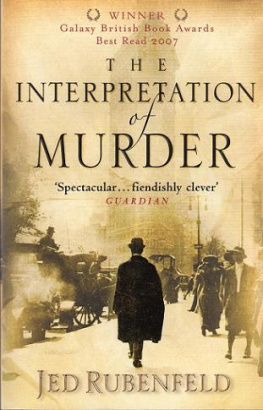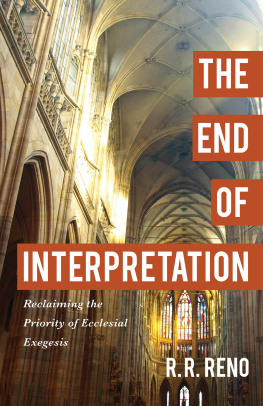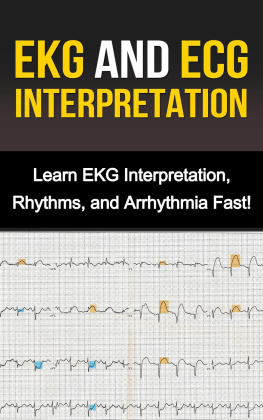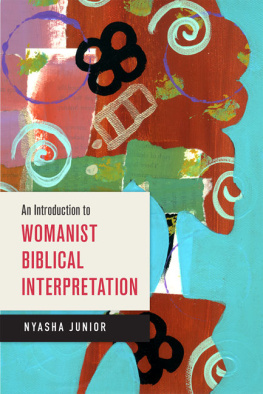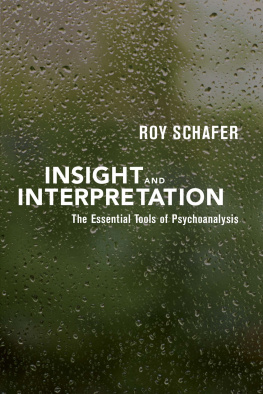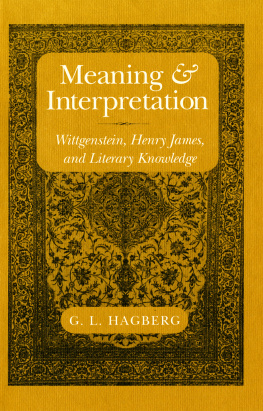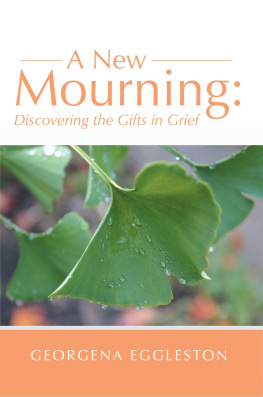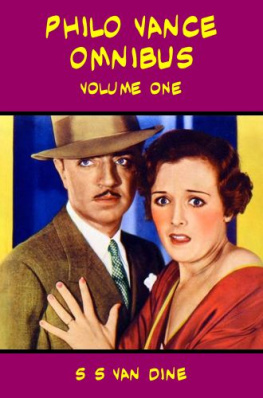Jed Rubenfeld - The Interpretation of Murder
Here you can read online Jed Rubenfeld - The Interpretation of Murder full text of the book (entire story) in english for free. Download pdf and epub, get meaning, cover and reviews about this ebook. year: 2007, genre: Detective and thriller. Description of the work, (preface) as well as reviews are available. Best literature library LitArk.com created for fans of good reading and offers a wide selection of genres:
Romance novel
Science fiction
Adventure
Detective
Science
History
Home and family
Prose
Art
Politics
Computer
Non-fiction
Religion
Business
Children
Humor
Choose a favorite category and find really read worthwhile books. Enjoy immersion in the world of imagination, feel the emotions of the characters or learn something new for yourself, make an fascinating discovery.
- Book:The Interpretation of Murder
- Author:
- Genre:
- Year:2007
- Rating:4 / 5
- Favourites:Add to favourites
- Your mark:
- 80
- 1
- 2
- 3
- 4
- 5
The Interpretation of Murder: summary, description and annotation
We offer to read an annotation, description, summary or preface (depends on what the author of the book "The Interpretation of Murder" wrote himself). If you haven't found the necessary information about the book — write in the comments, we will try to find it.
The Interpretation of Murder — read online for free the complete book (whole text) full work
Below is the text of the book, divided by pages. System saving the place of the last page read, allows you to conveniently read the book "The Interpretation of Murder" online for free, without having to search again every time where you left off. Put a bookmark, and you can go to the page where you finished reading at any time.
Font size:
Interval:
Bookmark:

Copyright 2006 Jed Rubenfeld
The right of Jed Rubenfeld to be identified as the Authorof
the Work has been asserted by him in accordancewith
the Copyright, Designs and Patents Act 1988.
First published in Great Britain in 2006 by
HEADLINE REVIEW
An imprint of HEADLINE PUBLISHING GROUP
First published in paperback in Great Britain in 2007 by
HEADLINE REVIEW
An imprint of HEADLINE PUBLISHING GROUP
Apart from any use permitted under UK copyright law, thispublication may
only be reproduced, stored, or transmitted, in anyform, or by any means,
with prior permission in writing of the publishersor, in the case of
reprographic production, in accordance with theterms of licences
issued by the Copyright Licensing Agency.
The Interpretation of Murder is a work of fiction inspired by the lives
of the historical figures in this publication.
Cataloguingin Publication Data is available from the British Library
ISBN 978 07553 3142 0 (B format)
ISBN 978 07553 3479 7 (A format)
Typeset in Bembo by Palimpsest Book Production Limited,
Grangemouth , Stirlingshire
Printed and bound in Great Britain by
Clays Ltd, St Ives pic
Headline's policy is to use papers that are natural,renewable and
recyclable products and made from wood grown insustainable forests.
The logging and manufacturing processes are expected toconform to
the environmental regulations of the country oforigin.
HEADLINE PUBLISHING GROUP
A division of Hachette Livre UK Ltd
338 Euston Road London NW1 3BH
www.headline.co.uk
www.hodderheadline.com
To Amy,
only , always
and to
Sophia and Louisa
Table of Contents
In1909, Sigmund Freud, accompanied by his then disciple Carl Jung, made his oneand only visit to the United States, to deliver a series of lectures onpsychoanalysis at Clark University, in Worcester, Massachusetts. The honorary doctoraldegree that Clark awarded him was the first public recognition Freud had everreceived for his work. Despite the great success of this visit, Freud alwaysspoke, in later years, as if some trauma had befallen him in the United States.He called Americans 'savages' and blamed his sojourn there for physicalailments that afflicted him well before 1909. Freud's biographers have longpuzzled over this mystery, speculating whether some unknown event in Americacould have led to his otherwise inexplicable reaction.
There is no mystery to happiness.
Unhappy men are all alike. Some woundthey suffered long ago, some wish denied, some blow to pride, some kindling sparkof love put out by scorn - or worse, indifference - cleaves to them, or they toit, and so they live each day within a shroud of yesterdays. The happy man doesnot look back. He doesn't look ahead. He lives in the present.
But there's the rub. The present cannever deliver one thing: meaning. The ways of happiness and meaning are not thesame. To find happiness, a man need only live in the moment; he need only livefor the moment. But if he wants meaning - the meaning of his dreams, hissecrets, his life - a man must reinhabit his past, however dark, and live forthe future, however uncertain. Thus nature dangles happiness and meaning beforeus all, insisting only that we choose between them.
For myself, I have always chosenmeaning. Which, I suppose, is how I came to be waiting in the swelter and mobof Hoboken harbor on Sunday evening, August 29, 1909, for the arrival of theNorddeutsche Lloyd steamship George Washington, bound from Bremen,carrying to our shores the one man in the world I wanted most to meet.
At 7 p.m. there was still no sign ofthe ship. Abraham Brill, my friend and fellow physician, was waiting at theharbor for the same reason as I. He could hardly contain himself, fidgeting andsmoking incessantly. The heat was murderous, the air thick with the reek offish. An unnatural fog rose from the water, as if the sea were steaming. Hornssounded heavily out in the deeper water, their sources invisible. Even thekeening gulls could be only heard, not seen. A ridiculous premonition came tome that the George Washington had run aground in the fog, hertwenty-five hundred European passengers drowning at the foot of the Statue ofLiberty. Twilight came, but the temperature did not abate. We waited.
All at once, the vast white shipappeared - not as a dot on the horizon, but mammoth, emerging from the mistfullblown before our eyes. The entire pier, with a collective gasp, drew backat the apparition. But the spell was broken by the outbreak of harbormen'scries, the flinging and catching of rope, the bustle and jostle that followed.Within minutes, a hundred stevedores were unloading freight.
Brill, yelling at me to follow,shouldered through to the gangway. His entreaties to board were rebuffed; noone was being let on or off the ship. It was another hour before Brill yankedat my sleeve and pointed to three passengers descending the bridge. The firstof the trio was a distinguished, immaculately groomed, gray-haired, andgray-bearded gentleman whom I knew at once to be the Viennese psychiatrist DrSigmund Freud.
At the beginning of the twentiethcentury, an architectural paroxysm shook New York City. Gigantic towers calledskyscrapers soared up one after the other, higher than anything built by thehand of man before. At a ribbon- cutting on Liberty Street in 1908, the tophats applauded as Mayor McClellan declared the forty-seven-story redbrick andbluestone Singer Building the world's tallest structure. Eighteen months later,the mayor had to repeat the same ceremony at the fifty-story Metropolitan Lifetower on Twenty-fourth Street. But even then, they were already breaking groundfor Mr Woolworth's staggering fifty-eight-story ziggurat back downtown.
On every block, enormous steel-beamskeletons appeared where empty lots had been the day before. The smash andscream of steam shovels never ceased. The only comparison was with Haussmann stransformation of Paris a half century earlier, but in New York there was nosingle vision behind the scenes, no unifying plan, no disciplining authority.Capital and speculation drove everything, releasing fantastic energies,distinctly American and individualistic.
The masculinity of it all wasundeniable. On the ground, the implacable Manhattan grid, with its two hundrednumbered east-west streets and twelve north-south avenues, gave the city astamp of abstract rectilinear order. Above this, in the immensity of thetowering structures, with their peacock-like embellishments, it was allambition, speculation, competition, domination, even lust - for height, size,and always money
The Balmoral, on the Boulevard - NewYorkers at the time referred to Broadway from Fifty-ninth to 155th Street asthe Boulevard - was one of the grand new edifices. Its very existence was agamble. In 1909, the very rich still lived in houses, not apartments. They'kept' apartments for short or seasonal stays in the city, but they failed tocomprehend how anybody could actually live in one. The Balmoral was a bet: thatthe rich could be induced to change their minds if the accommodations weresufficiently opulent.
The Balmoral rose seventeen stories,higher and grander than any apartment building - any residential building - hadever climbed before. Its four wings occupied an entire city block. Its lobby,where seals cavorted in a Roman fountain, shone with white Carrera marble.Chandeliers in every apartment sparkled with Murano glass. The smallestdwelling had eight rooms; the largest boasted fourteen bedrooms, seven baths, agrand ballroom with a twenty-foot ceiling, and full maid's service. This rentedfor the appalling sum of $495 a month.
Font size:
Interval:
Bookmark:
Similar books «The Interpretation of Murder»
Look at similar books to The Interpretation of Murder. We have selected literature similar in name and meaning in the hope of providing readers with more options to find new, interesting, not yet read works.
Discussion, reviews of the book The Interpretation of Murder and just readers' own opinions. Leave your comments, write what you think about the work, its meaning or the main characters. Specify what exactly you liked and what you didn't like, and why you think so.

